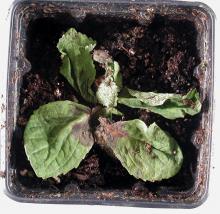See:
Greenhouse Plants, Ornamental - Gray Mold
Cause Botrytis cinerea, a fungus. The disease is most prevalent in cool, moist environments and/or where overhead sprinklers wet plants for long periods of time. Infection requires 5 to 8 hours of wetness. This fungus colonizes dead, dying, and wounded plant parts. From these infections they can attack healthy tissues. Conidia are ubiquitous and may come from several sources. It is found everywhere plants are grown and has a wide host range from ornamental to agronomic crops. Flower petals are most susceptible at any stage of development. Leaf blights can start when infected floral tissue falls on healthy leaves. All species are susceptible but bigleaf hydrangea is highly susceptible.
Symptoms Initial symptoms are water-soaked spots on petals, which develop reddish-brown irregular blotches that may eventually cover the whole flower. Petals turn brown and fall. Leaf spots form, especially where faded petals have fallen. Flower buds may die before opening. A fuzz of grayish brown fungal sporulation will grow out of dead leaf or stem tissue under humid conditions. Cutting rots and young plant blights are also possible.
Cultural control Sanitation should not be practiced when plants are wet.
- Space plants to ensure good air circulation.
- Avoid wounding leaves or shoots.
- Avoid sunburn by planting in shadier locations.
- Maintain low humidity in the greenhouse.
- Avoid overhead or late-evening watering.
- Regularly remove crop debris as soon as possible especially spent blooms.
Chemical control Best when used with cultural controls. Tank-mix and/or alternate products from different groups with different modes of action to prevent the buildup of resistant fungi. Limit the use of any one group during crop production.
- Astun at 10 to 17 fl oz/100 gal water. Group 7 fungicide. 12-hr reentry.
- Bonide Fung-onil Multi-purpose Fungicide at 2.25 teaspoons/gal water. H
- Broadform at 4 to 8 fl oz/100 gal water. Group 7 + 11 fungicide. 12-hr reentry.
- Chipco 26019 FLO at 1 to 2.5 quarts/100 gal water. Group 2 fungicide. 12-hr reentry.
- Daconil Weather Stik at 1.38 pints/100 gal water. Foliage only. Group M5 fungicide. 12-hr reentry.
- Decree 50 WDG at 0.75 to 1.5 lb/100 gal water. Group 17 fungicide. 12-hr reentry.
- Mancozeb-based products can be used as mixing partners and provide some protection. Group M3 fungicides. 24-hr reentry.
- Fore 80 WP at 1.5 lb/100 gal water plus a spreader-sticker.
- Protect DF at 1 to 2 lb/100 gal water plus 2 to 4 oz spreader-sticker.
- OHP 6672 4.5 F at 10 to 14.5 fl oz/100 gal water plus another fungicide. Group 1 fungicide. 12-hr reentry.
- Orkestra at 8 fl oz/100 gal water. Group 7 + 11 fungicide. 12-hr reentry.
- Pageant at 12 to 18 oz/100 gal water. Do not use with organosilicone-based adjuvants. Group 7 + 11 fungicide. 12-hr reentry.
- Palladium at 4 to 6 oz/100 gal water. Avoid excessive runoff to small plants, which may result in stunting and/or chlorosis. Group 9 + 12 fungicide.12-hr reentry.
- Phyton 27 at 1.3 to 2.5 oz/10 gal water. Group M1 fungicide. 48-hr reentry.
- Postiva at 10 to 28 fl oz/100 gal water. Group 3 + 7 fungicide. 12-hr reentry.
- Spectro 90 WDG at 1 to 2 lb/100 gal water. Foliage only. Group 1 + M5 fungicide. 12-hr reentry.
- Terraguard SC at 4 to 8 fl oz/100 gal water. Group 3 fungicide. 12-hr reentry.
Biological control
- BotryStop (Urocladium oudemansii U3 strain) at 2 to 4 lb/A. Keep refrigerated before use. Compatible with many wetting agents, some fungicides and biologicals but not all. Unknown efficacy in the PNW. 4-hr reentry. O
Reference Peterson, J.L. and Davis, S.H. 1970. Suppression of Erysiphe polygoni and Botrytis cinerea on Hydrangea with benomyl. Plant Disease Reporter 54:606-607.



